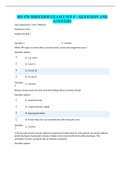Summary
Summary Pearson Edexcel AS Level Geography - Coasts
- Institution
- PEARSON (PEARSON)
Detailed and comprehensive notes on coasts (unit 1 topic 2B of Pearson Edexcel AS Level Geography). Covers: the coastal zone, waves, weathering, mass movement, geology, coastlines, coastal landforms, salt marshes and sand dunes. Case studies include: Stair Hole, Lulworth Cove, Durdle Door, Oswald's...
[Show more]












